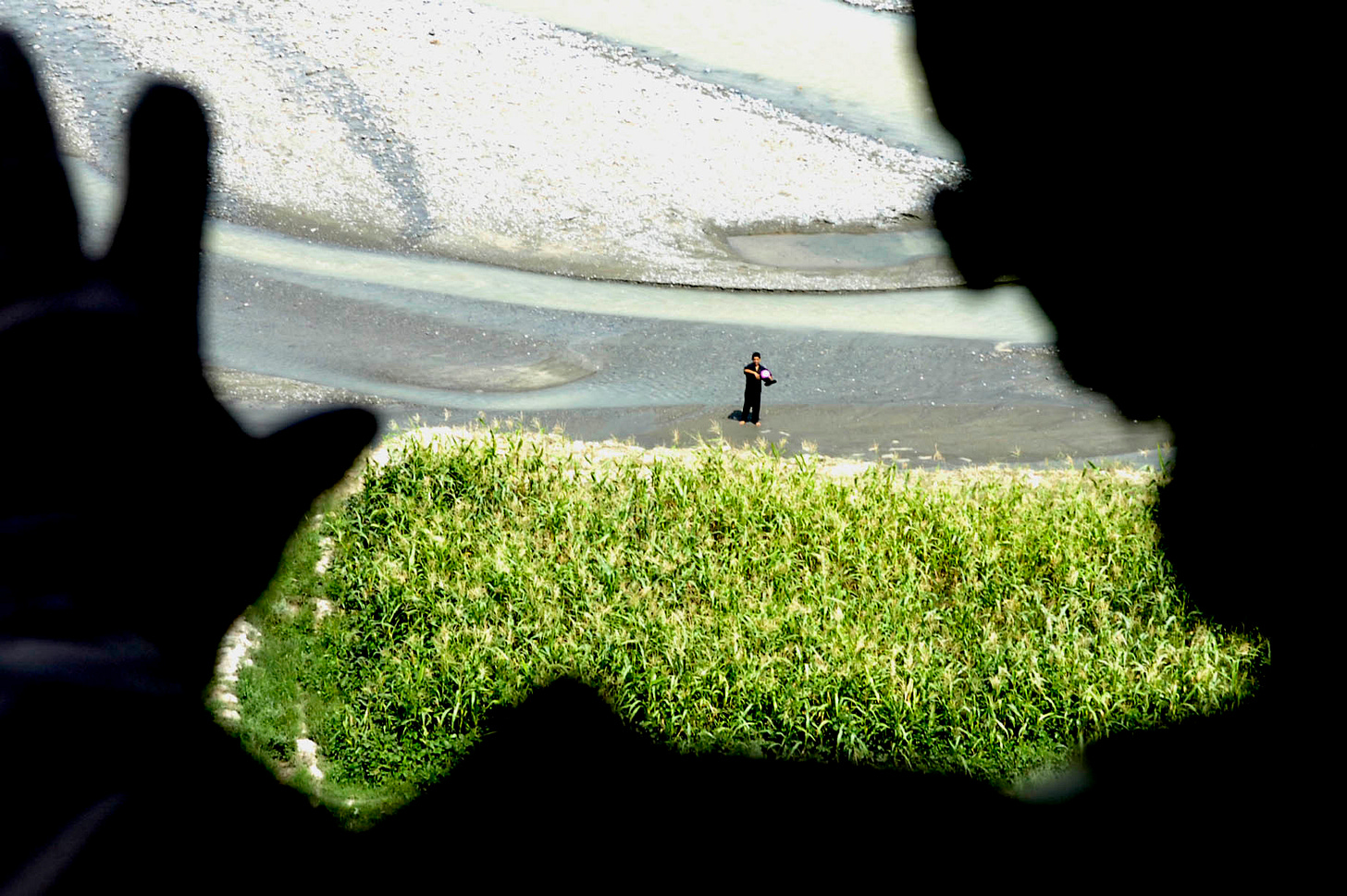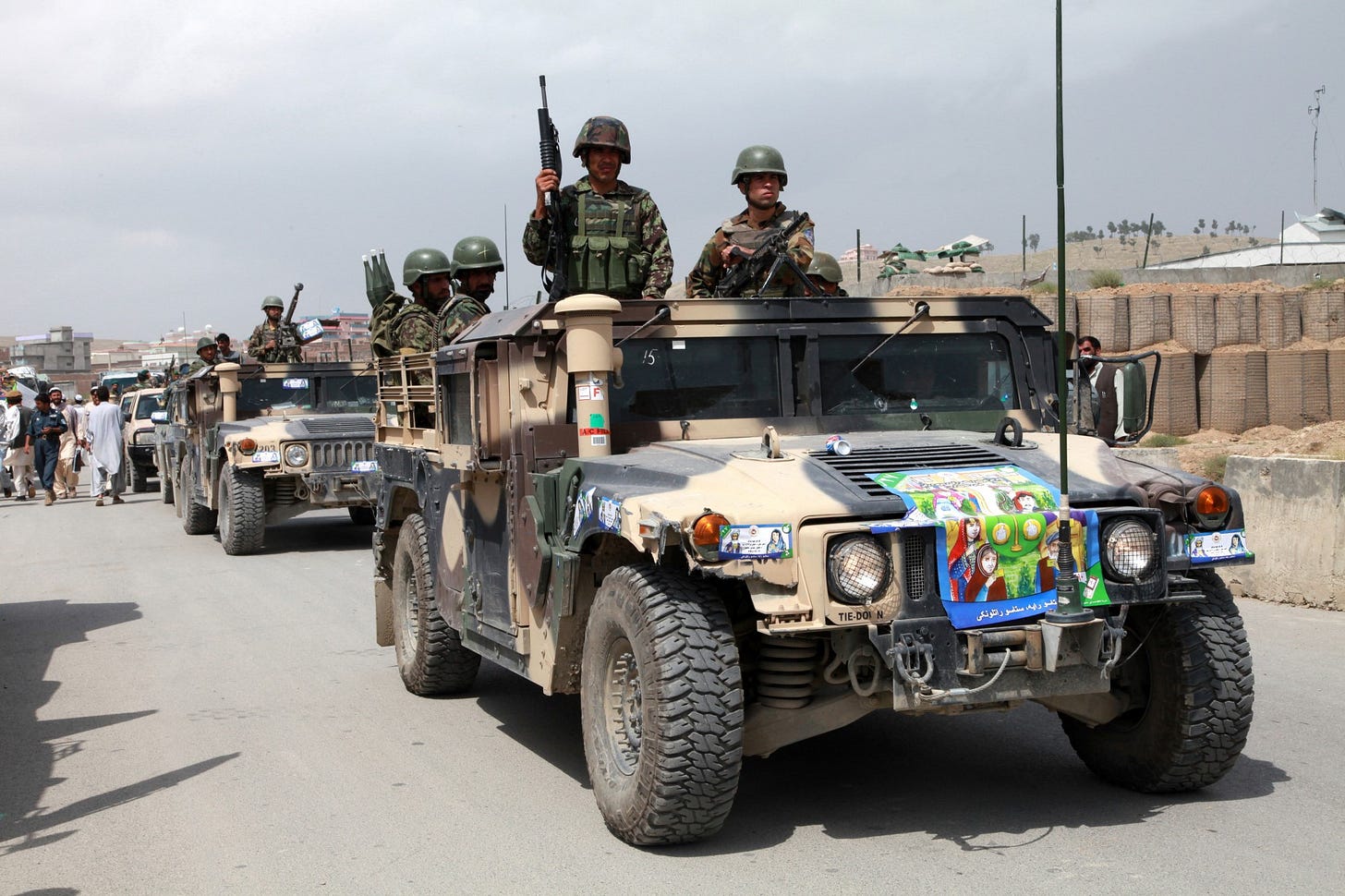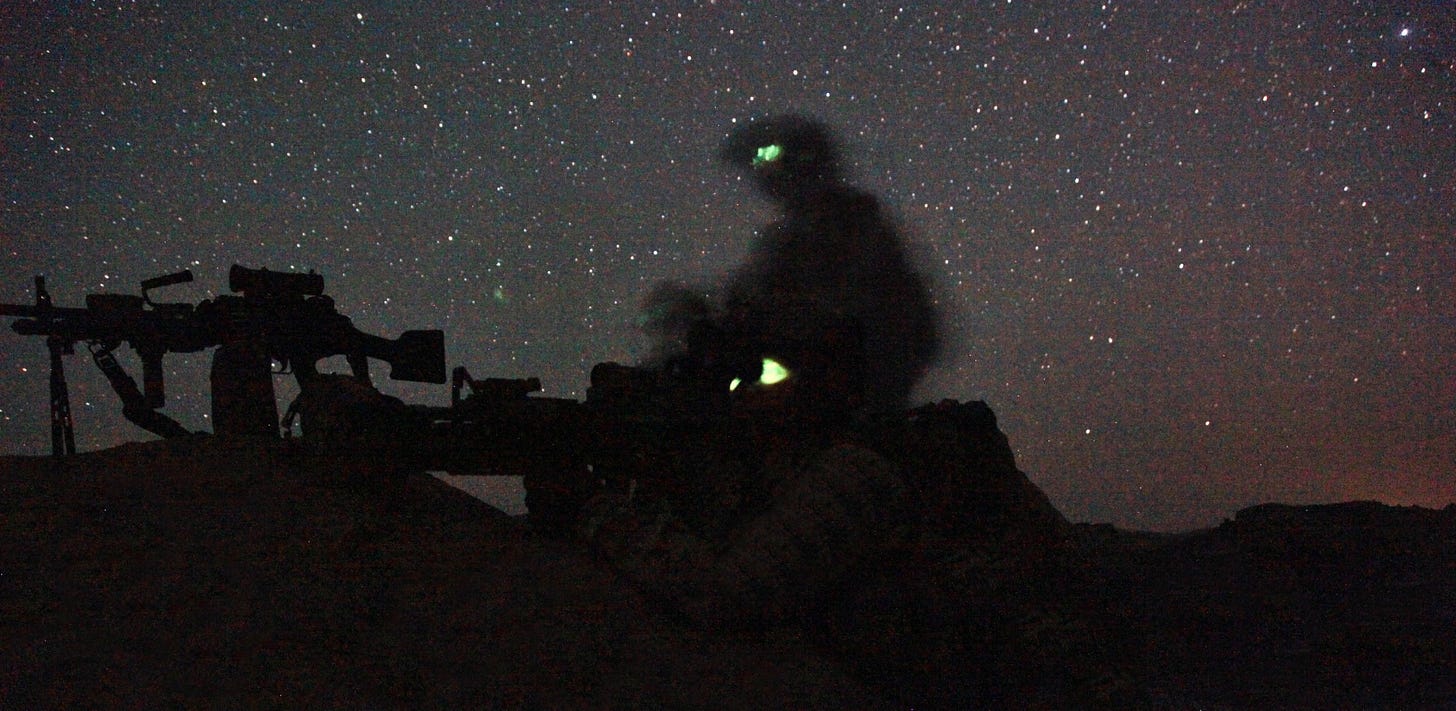The Long Undeath Of Forever War Heroes
War without meaning becomes the stories we tell ourselves.
In the absence of all else, time is a force that gives war meaning. On April 14, the Biden administration turned to the sanctity of calendars and round numbers to bless a future US exit from Afghanistan.
“US troops as well as forces deployed by our NATO allies and operational partners will be out of Afghanistan before we mark the 20th anniversary of that heinous attack on September 11th,” said Biden, before going on to say, “But we’ll not take our eye off the terrorist threat.”
Setting a date on the anniversary of the terror attack that became the cassus belli for the United States is as arbitrary as any end point. At the very end of his remarks, Biden acknowledges this distance between the date picked and the previous objectives given for the way.
“Bin Laden is dead and Al-Qaeda is degraded in Afghanistan. And it’s time to end the forever war,” said Biden.
It is noteworthy, I think, that Biden picked not the anniversary of the US invasion (that would be October 7) nor the formal authorization of war (September 14th by Congress, signed into effect September 18th by President George W. Bush). Either of those would reveal the choice of when and how to fight, of the legal mechanism that moved people and materiel to violence. Instead, the withdrawal date will fall on the second decade anniversary of the attack, deliberately building meaning out of an arbitrary symmetry.1
Generational as the US war in Afghanistan is, the lack of a clear narrative at the end might lead people to believe there was once a clear narrative at the beginning. Not hardly. If there was ever a prospect for a clear and limited war, it was lost in the caves of Tora Bora and the world-warping ambitions of the Bush Administration. Let’s tackle the latter first.

The 2001 AUMF, the expansive bill that launched the US War in Afghanistan, and continues to animate war in at least a half-dozen theaters today, is broad in its definition of the foe.2
It reads:
the President is authorized to use all necessary and appropriate force against those nations, organizations, or persons he determines planned, authorized, committed,or aided the terrorist attacks that occurred on September 11, 2001,or harbored such organizations or persons, in order to prevent any future acts of international terrorism against the United States by such nations, organizations or persons
President George W. Bush, in a speech given to Congress two days after he signed the AUMF, and six days after Congress passed it, is similarly expansive. The speech is best remembered for “Either you are with us or you are with the terrorists,” a warning specifically linked to harboring or aiding terror groups.
That line would, in a short amount of time, become an expansive call-out questioning the patriotism or sympathies of anyone who questioned subsequent Bush foreign policy decisions, most especially the launching of the Iraq War.3
The speech also set in motion the move towards an Office of Homeland Security (which would eventually become a department, institutionalizing the forever war at home). Yet what captivates me here, what gives the forever war its expansive context, is how Bush specifically named the enemy.
“Our enemy is a radical network of terrorists and every government that supports them,” Bush said, to Congressional applause. He continued, “Our war on terror begins with Al Qaeda, but it does not end there. It will not end until every terrorist group of global reach has been found, stopped and defeated.”
In the speech Bush issues an ultimatum to the Taliban ruling Afghanistan, demanding among other things that as the government of Afghanistan they “hand over every terrorist and every person and their support structure to appropriate authorities” and “Give the United States full access to terrorist training camps, so we can make sure they are no longer operating.”
No such immediate handover happened, and the United States invaded in October. By December, the focus was on a cave complex in the mountain of Tora Bora, where the US believed bin Laden to be hiding. The battle, as drily noted on Wikipedia, was a “US-led tactical victory but strategic failure;” bin Laden would remain at large for a decade more, and the US in Afghanistan at least a decade beyond that.
Bush’s Axis of Evil speech, which famously expanded his focus from Afghanistan to Iraq, came just 44 days after the conclusion of the Battle of Tora Bora. The Taliban are never mentioned by name in the speech, as Bush instead frames Afghanistan as a model of success and a rebuilding project that the US will start in his term.
Instead, the threat is the amorphous terrorists, “Thousands of dangerous killers, schooled in the methods of murder, often supported by outlaw regimes, are now spread throughout the world like ticking timebombs, set to go off without warning.”
A few paragraphs later, the speech sets up this amorphous mass of ambient, time-sensitive danger as linked to North Korea, Iran, and Iraq.4
The linking is two-fold: first, to find a semi-plausible armory for deadly weapons, and secondly, to name a point on the map that could be perfected with violence.
When Bush names the Axis of Evil, it isn’t just those three countries, but “States like these and their terrorist allies” that “constitute an axis of evil.”
That dual gambit, to convince the American public that Iraq was armed with weapons of mass death, and that Iraq was working with terrorists, paid off. Polling in the lead up to the US invasion of Iraq found that “majorities or sizeable pluralities of Americans believed that Saddam Hussein was also personally involved in the attacks of 9/11,” a claim for which there was no evidence.5
It is I think on the whole good that many people politically aware in 2003 now position themselves as having been against the war then, but it’s a disservice to historical memory to forget just how effective Bush was at convincing the public of his narrative, and how unskeptical most media was at the time. (It is also a disservice to Black Americans, who were strongly skeptical of the war, by a gap of 49 points in March 2003).
Between the failure at Tora Bora and the launch of the Iraq War, as the Bush Administration built the case for the war, it set about crafting a narrative that the War on Terror would be redemptive for the nation, would usher in a new era of righteous action.

Bush’s 2002 West Point address is one of his more direct appeals to remaking the world through organized violence. It was taught to me in undergrad, back in the spring of 2009, as the chief document of his strategy. It is expansive, with an unreachable definition of victory, and contains whole sections about the need for ballistic missile defense to defeat terrorists, for some reason.
Reading it again today, two parts stand out. The first is this line: “We will not leave the safety of America and the peace of the planet at the mercy of a few mad terrorists and tyrants. We will lift this dark threat from our country and from the world.” Again, the dual focus on uprooting target states in the name of defeating nonstate actors.
The second part of the speech that stands out is a quip, one Bush attributes to George C. Marshall, about wanting a “West Point football player” for a special mission.
The same day Bush gave his West Point address, Arizona Cardinals safety Pat Tillman announced his decision to enlist in the Army, alongside his brother Kevin. It wasn’t the West Pointer Bush was hoping for, but it was the kind of all-American narrative his administration would be happy to lean on.
It was the anniversary of Pat Tillman’s death, along with the now ritualized internet mourning and relearning of his death, that prompted this specific issue of Wars of Future Past.
Tillman’s enlistment, along with his exit from the NFL, was covered as a major story, a bright example of civic sacrifice and selflessness from a thoughtful young man.
“Pat Tillman's story has earned national attention. He is believed to be the first N.F.L. player since World War II to leave the game voluntarily for military service,” the New York Times reported on June 1. The story concluded, “The brothers have declined to be interviewed for fear that their decision will be interpreted as a publicity stunt”
As the brothers Tillman declined press, the mythologizing continued. Mark Shields used their July enlistment as fodder for a column where he compared Pat to the recently deceased Ted Williams, and contrasted Tillman’s spirit of civic-minded service against the “celebrated businessmen who would -- and did -- do anything for money, and who now come to Washington to take the Fifth Amendment,” a reference to the ongoing investigations around Enron.
In a story published September 7, 2002, the Washington Times records Senator John McCain as saying "Perhaps the last vestiges of the Vietnam War have disappeared in the rubble of the World Trade Center. I don't think there will be any doubts about [Pvt. Tillman's] capabilities as a soldier, but also as a recruiting tool. He'll motivate other young Americans to serve as well."
This sort of mute hagiography continues to the present. Tillman’s decision to refuse a press spectacle around his service created an opportunity for grifters to fill the blank space offered by his principled stand.
Here is the narrative of Pat Tillman, as brought back by The Bleacher Report on April 22nd, 2021:


“Tillman was killed in Afghanistan 17 years ago today,” in particular, is an especially egregious framing, the passive voice skipping over the fact that he was shot to death by rangers in his own unit, an incident of friendly fire that was long covered up.
That’s a point I’ll return to later, but what stands out about the Bleacher Report tweet is how seamlessly it fits into the dominant narrative of Tillman upon his enlistment. The nature of the death a secondary factor in a broader story about personal sacrifice and civic duty, wielded cynically by a nation in one war and being steered directly into another.
For the next part of this narrative, I am going to lean heavily on the Behind The Bastards episode about Pat Tillman, or more specifically, about the people who covered up his death.
Before they would deploy to Afghanistan, the Tillmans, now rangers, were sent to Iraq. The Tillmans were present at the rescue of Jessica Lynch, a standalone moment of the war as telling as any.
“She Was Fighting to the Death” read the Washington Post’s April 3rd, 2003 story. The invasion of Iraq took place just 15 days before the story was published. The reporters, quoting official sources, painted a picture of a brave supply clerk, thrust into an ambush by accident, fighting until she couldn’t, who was then held in a hospital with a “prototype Iraqi torture chamber” on site, until she was rescued in “a classic Special Operations raid.”
Lynch’s unit had been ambushed, and she was collected by special forces, but virtually every other part of that story was wrong. The hospital where she was had tended to her wounds and tried to arrange a transfer to American forces. The errors would start to emerge over the course of the summer, while the Bush administration rode the triumphant and mostly fabricated narrative it had planted in the press.
Tillman, a prolific diarist, observed “that the build-up of forces around the Lynch rescue suggested “a big Public Relations stunt,”” as Ryan Devereaux noted for The Intercept.6
The Post, which broke the Jessica Lynch story, launched investigations into its own coverage, the first appearing June 17, 2003. A second Post follow-up, which ran June 29, concluded “This was the single most memorable story of the war, and it had huge propaganda value. It was false, but it didn't get knocked down until it didn't matter quite so much.”
Tillman’s death would come just over a year after the Lynch raid. It would come in Afghanistan, while on patrol with other rangers.
A 2006 story published by Sports Illustrated offers the most evocative look at the exact lead-up to the firefight where another ranger shot Tillman dead. The context is broadly familiar big clusterfuck borne out of little clusterfucks, small failings all spiraled in on each other. A broken vehicle, a commander’s desire to see a village cleared before a return to base. A lack of reliable communications. The platoon split, and then the part of the platoon that was supposed to take the broken vehicle back on a tow truck instead returned to the main route. The canyon walls, explosions and confusion. Soldiers primed for fear of ambush. And then, the fatal shots, hitting first the allied Afghan national army soldier next to Pat Tillman, and then Tillman.
In my writing, I often try to emphasize that war is a thing humans do. It is also a thing humans do under duress, in conditions that make clear perception difficult at the precise moments it is most important.
“Friendly fire” is a garbage euphemism, but so are most euphemisms for military violence. Targets engaged, enhanced lethality, suspected enemy combatants, everything turns the act of deliberately tearing apart human bodies into detached actions. These terms lend themselves to passive voice.
“Was killed by friendly fire,” becomes an accident, like getting caught in a hail storm, while “shot by his own unit, who mistook him for the enemy” at least identifies how the killing happened. Sometimes in war, friendly fire doesn’t end in deaths, as the two groups figure out the identity of their suspected foes, and stop firing in time.
On April 22, 2021, in response to both the lack of context in the Bleacher Report tweet, and the separate story about Bush decrying misinformation, I said this: “The murder of Pat Tillman is one of those things that if explained in plain language reads as conspiracy theory, because surely there’s no way that the poster boy quarterback who quit to join the war grew disillusioned & was shot by his own unit before he could get publicly vocal.”
Apart from the position Tillman played (safety, not quarterback), I maintain that most of this is accurate, though the framing implies a far more causal route from his skepticism of the war to his death. And I wouldn’t be 3,000 words deep into this if I didn’t think the story deserved more from me than mere superficial technical accuracy.
In a long twitter conversation with Andrew Exum, who was one of the rangers called to respond to Tillman’s death that night, we parse several meanings. “Manslaughter” might be a closer legal read than “murder,” since it at least removes the implication of deliberate killing of a specific individual. The malice in the process, if it can be found anywhere, is located more properly in the chain of command that repeatedly supported a cover-up, protecting a myth far more than the truth.
Tillman’s disillusionment, as has been documented, was kept mostly to private journals and private correspondence,and while much has been made of his plans to meet with Noam Chomsky after his enlistment was up, it is impossible to say what public action about the wars he would have taken, if any. It is too much to conscript the dead into service as avatars of our political counterfactuals.
While Tillman’s death was known to the Army immediately as from his own unit, it took much longer for that information to become public.
“Four weeks after the memorial service, Kevin Tillman’s sergeant pulled him aside at their stateside base and told him his brother had been killed by friendly fire. Their mother, Mary, got the news from a reporter calling her for comment,” Devereaux wrote. “The military withheld key facts from the Tillman family even as it admitted the broad strokes of his death.”
The lengthy investigations into Pat Tillman’s death, and the cover-ups, are a story well told in their own right. (I think the Behind the Bastards episode, Sports Illustrated, and The Intercept all explain it well). The story is full of little tells, like how the wording of his posthumously presented Silver Star was careful to name the crossfire but not attribute his death to an enemy. Or how the national pageantry of his death became an election year story, leaving the truth to arrive only long Bush had secured stewardship of the forever war for a second term.
What I think is most salient, what stands out to me, is this quote from his mother Mary Tillman, told to Dave Zirin in a story published June 2008.
“The lie about Pat was not simply a lie to our family, it was definitely a lie to dupe the public; to deflect their attention away from the atrocities of Abu Ghraib, Fallujah, and of course they wanted people to disregard the president's sad approval ratings, and the casualties,” Mary Tillman said. “It's really important for people to understand: this was done to deceive them.”
In the absence of clear proof that the war had met its stated objectives, the White House instead built little narratives of success. The “Mission Accomplished” banner is the most transparent, but both Jessica Lynch’s staged rescue and Pat Tillman’s demise by American bullets became narrative. Through an almost alchemical process the Bush administration transmuted classified information and real human death into stories it could wear as armor against criticism.
Thank you all for reading this. I genuinely enjoy writing these newsletters every fortnight, and I will keep writing them in some form for as long as I can sustain myself doing so.
Last month, I sent out a survey about the future of this newsletter at Substack. I had anticipated sending at least a second newsletter in April, and so I’ve extended the survey deadline. If you’ve read this far, please take a minute and help me better understand what you hope to get out of Wars of Future Past.
This survey link will be open until May 24th, 2021. Sometime not too long after that, I’ll make a call about staying at Substack or porting this whole production elsewhere. As a reader and a subscriber, very little will change on your end if I do make the change, but I want to be above-board before making it.
If you’re in the mood for more free newsletters, may I recommend checking out what we’re doing over at Discontents? Our latest issue features the BORDER/LINES crew talking about how Trump-era asylum denials might permanently prevent family reunification, without congressional action.
It is easy to forget, but the US invading Afghanistan after 9/11 was not a fixed, inevitable outcome. I’m particularly partial to Alex Thurston’s post on this at Foreign Exchanges, where he writes “The 9/11 attacks became a turning point for America because Americans, and in particular some very powerful Americans, decided it would be.” [emphasis mine]
Gregory Johnson’s 2014 story “60 Words And A War Without End: The Untold Story Of The Most Dangerous Sentence In U.S. History”, now seven years old, remains the single best read on this.
If you want the feeling of the era’s pop culture war boosterism condensed into six minutes, this video of an Iraq War debate between two WWE wrestlers from April 14, 2003, is pretty close.
That Bush’s Axis of Evil states builds on Clinton’s Outlaw States is one of those lost continuities of the 1990s to the 2000s, but it’s an important one to remember. I’m convinced history will see the Gulf War as just an early stage of the Forever War, rather than a wholly distinct occurrence
Paul Musgrave, of Public Domain Warfare fame, resurfaced this polling last week, especially noting that in 2003 40% of Democrats believed Iraq to be pursuing nuclear weapons, and a further 46% thought such action was likely.
Devereaux’s story, from 2017, was prompted by President Trump retweeting an account that used Tillman’s death in war as a cudgel against Kaepernick’s protest.





